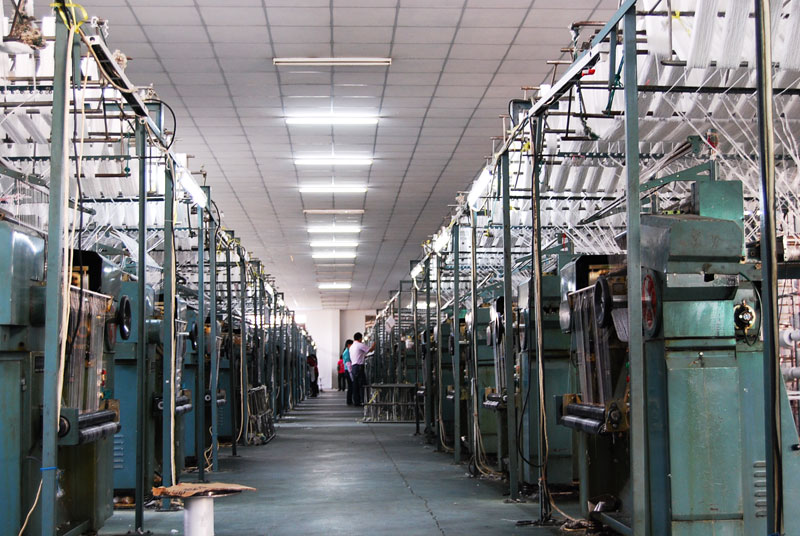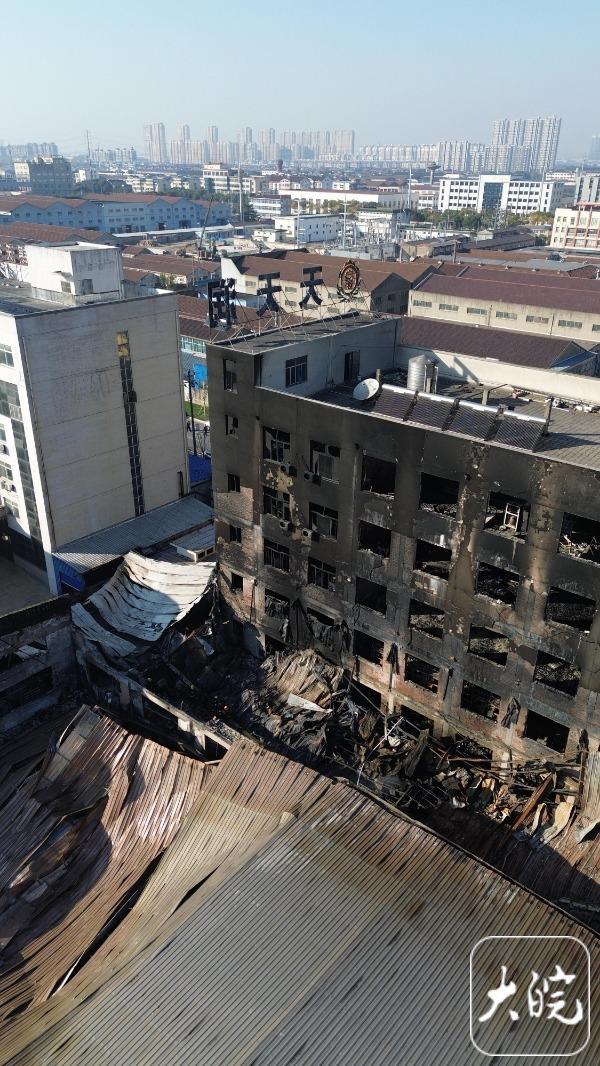On the evening of 20 November 2023, a fire broke out on the first floor of a textile factory in Wuxi, Jiangsu province, killing seven workers on the fourth floor of the five-storey building. The fire also damaged nearby warehouses and workshops, and neighbouring factories were left without power in the two days after the accident.

A drone image from Dawan News shows the five-storey Tiantianrun factory building’s charred exterior, and the effect on the crowded surrounding area. Source: Dawan News
Domestic media reported that all seven workers who lost their lives were women migrant workers from Guizhou and Shandong provinces. They were employed at the building owned by Wuxi Tiantianrun Textile & Technology Co. Ltd (无锡天天润纺织科技有限公司), which produces fancy yarns for the international market. The fourth floor where they worked was rented out to another corporate entity that CLB has not been able to verify.
Tiantianrun is one of the major fancy yarns manufacturers in China and supplies to notable brands including Lion Brand Yarn (U.S.) and to retailers including TEDi (Germany), Action (Netherlands), and Hema (Netherlands).
First-floor warehouse caught fire and workers were unable to escape from fourth-floor workshop
Jimu News reported on the fire and spoke with a Mr. Yang, the brother-in-law of a deceased worker. On 22 November, he told reporters his sister-in-law was in her 50s, and her husband also worked in Wuxi. The couple supports three children. The family is from Linyi, Shandong province, and Mr. Yang rushed from Linyi upon hearing the news.
Someone close to another victim of the fire said that the deceased worker was from a rural area of Guizhou province. Her husband was unable to work due to illness, and she supported four children at home.
Nearby workers told Apex News that over 200 people worked at Tiantianrun, while the company’s 2022 annual report indicates that 94 employees were registered for social security payments. CLB found that according to the corporate database Tianyancha, the company “had not provided authentic or complete data” to the local authorities.

A Tiantianrun production line. Source: Tiantianrun website
Eyewitnesses said that the narrowness of the roads leading to the factory delayed the firefighting and rescue. A nearby tenant said that the blaze lasted for one hour.
A worker on-site witnessed the fire and described it as so intense that the whole building was in flames.
The district-level emergency management bureau in Huishan told the press that the accident investigation was underway and that two individuals deemed responsible at the factory had been detained. Two days after the fire, Tiantianrun workers were still not permitted to enter the premises to retrieve their personal belongings.
The Tiantianrun factory fire began on the first floor of the building, which - along with the third and fifth floors - was warehouse space. The second and fourth floors are production line workshops.

A drone image from Dawan News shows the five-storey Tiantianrun factory building after the fire. Source: Dawan News
A worker who escaped from the blaze was on the first floor when the fire started, and she immediately ran out of the building. But she said the fire burned quickly, and those on the fourth floor were unable to escape or did not know of the danger below them until it was too late.
A safety inspection of nearby premises was conducted after the fire to eliminate other safety hazards. But as CLB has advocated for years, post hoc inspections cannot bring back the lives of those lost in workplace accidents.
China’s safety management system should better prevent accidents before they occur - rather than simply responding after the fact. Further, China’s official trade union has a role to play in understanding and eliminating the risks apparent to front-line workers and that are systemic across a particular industry.
Manufacturing areas in China exhibit patterns of safety risks, and international actors should take steps to ensure their supply chains are safely operated
Although the official investigation report of the Tiantianrun factory fire will likely not be available for several months, the characteristics of this incident, as reported by eyewitnesses to domestic media, follow patterns of well-known safety risks in the industry.
The similarities to the November 2022 fire that took the lives of 42 garment factory workers in Anyang, Henan province, are striking. For example, the practice of crowding warehouse space and factory space in the same building presents dangers to workers when flammable materials are not properly stored.
Property owners who lease out parts of their buildings to multiple corporate tenants without following safety regulations also contribute to fire hazards among different enterprises.
Lack of safety protocol and safety equipment is another common feature of manufacturing accidents that take workers’ lives.

Photograph: Olya Maximenko / Shutterstock.com
Although those who worked nearby told media that the Tiantianrun factory is well-known in the area, a representative from the Huishan district emergency management bureau said that the factory is not a key enterprise in the jurisdiction and safety inspections are therefore the responsibility of the sub-district office. The representative said these inspections should occur once every two months.
No matter how often these inspections should or do occur, regulatory authorities will be hard-pressed to observe all companies in their jurisdictions at all times. Therefore, the role of frontline workers in identifying and raising safety hazards in the normal course of their work should become a priority, in line with provisions in China’s Work Safety Law.
Implementing such a mechanism would go a long way in preventing workplace accidents in China. To do this would require trade union officials to regularly interact with workers and represent them before their employers to urge for safer working conditions before problems arise.
International actors with supply chains in China should ensure they understand and take steps to ameliorate the safety risks systemic in China’s manufacturing industry, that workers in their supply chains are guaranteed the freedom of association and adequate representation under China’s Trade Union Law, and that workers and their families affected by workplace accidents are compensated according to domestic laws and humanitarian principles.
Further CLB reading:
- Thirty years after the Zhili Toy Factory fire, workplace safety measures still lacking in manufacturing industry (November 2023)
- Garment factory fire in Anyang takes 38 lives, injures 2 (November 2022)
- What You Need to Know About Workers in China: Work safety (last updated September 2021)
